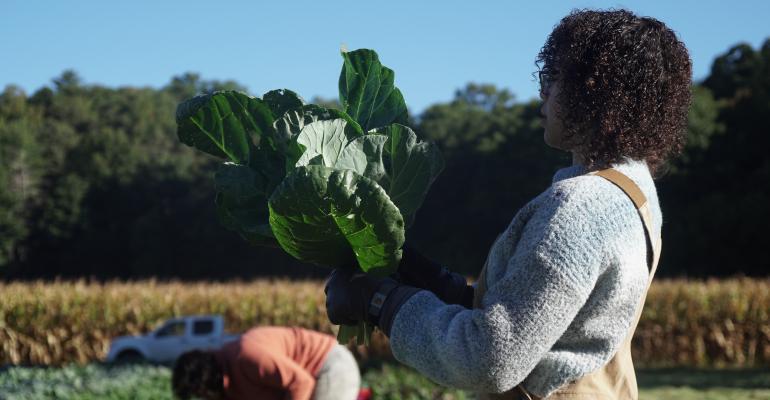This article does not necessarily reflect the opinions of the editors or management of Food Management.
Using meat and produce raised on the campus farm at Warren Wilson College, diverting food waste to feed a worm farm at Virginia Wesleyan University, highlighting local produce at SUNY Oneonta, setting out color-coded cards to indicate the carbon impact of different dishes at George Mason University: these are some examples of how campus dining programs managed by Sodexo are working sustainability into their operations. Here’s a closer look at these three initiatives. --Mike Buzalka, executive editor, FM
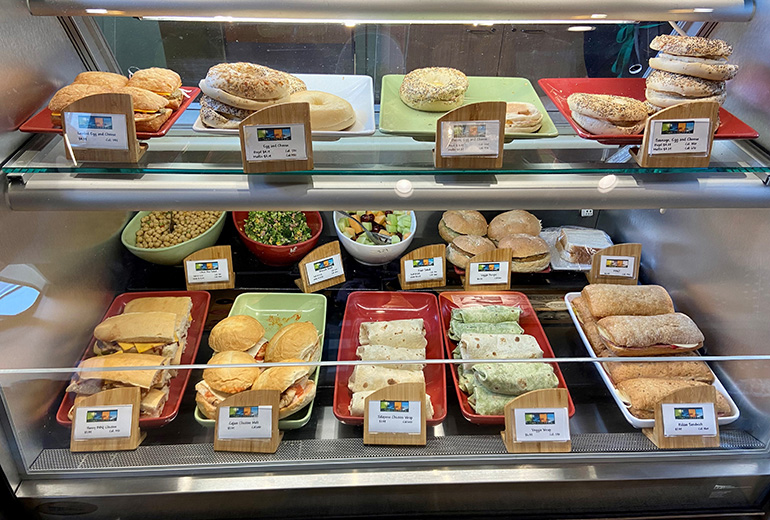
Seasons at SUNY Oneonta uses the freshly baked bread from Oneonta’s dining full-service bakery, including 110 dozen bagels made in nine different varieties every week.
Highlighting local eating at SUNY Oneonta’s Seasons
One part of maintaining a sustainable diet is eating local, seasonal produce, and SUNY Oneonta’s Seasons café makes it easy to do so.
Seasons opened eight years ago with an idea to create a retail location that offered as much sustainable, local, organic products as possible, Oneonta Dining GM Jimmy Hamm said.
“The idea behind Seasons is we tie in all four seasons through the two semesters,” Hamm said. “We work with our produce company to create new menus regularly based off the growing seasons.”
Beyond that, Seasons also uses the freshly baked bread from Oneonta’s dining full-service bakery, including 110 dozen bagels made in nine different varieties every week. The location also sells items from local honey from McCoy Honey in Oneonta, maple syrup from Shaver Hill Farm in Harpersfield, and uses milk from Ronnybrook Farm located in the Hudson Valley. The coffee is from Stagecoach Coffee in nearby Cooperstown and Divinitea organic loose leaf hot and iced teas from Schenectady are also sold on location.
 Photo: Display at SUNY Oneonta tabulates the local sources of the various products being served.
Photo: Display at SUNY Oneonta tabulates the local sources of the various products being served.
Oneonta Dining Marketing Specialist Joanna Foti then tells the story of the farmers they’re working with on a bulletin board in Seasons, to inform customers about the journey of the food and its local roots.
“Opening Seasons allowed us to bring in more local products,” Hamm said. “Students love Seasons and they love the product in there.”
Beyond Seasons, Oneonta Dining has also incorporated local food into the dining hall, with a Farm Fresh Station at Mills Hall, where they additionally have a small-scale composting program. Though they’re starting small with the composting, they are looking forward to opportunities to expand and grow this program.
“We’re ready to go, we’ll do whatever it takes to make a larger-scale composting program happen,” Hamm said.
He added that he is passionate about sustainability because he grew up on a farm.
“I know what it means to the farms and small business to have these opportunities,” Hamm said. “And it helps contribute to overall sustainability.”
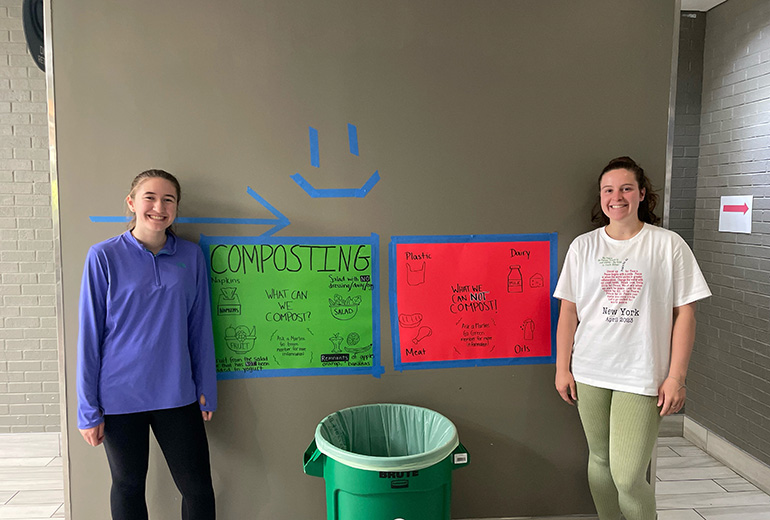
For over a decade, Virginia Wesleyan Dining has been collecting salad bar and other prep area scraps in containers rather than throwing them away, Dining General Manager Tim Lockett said.
Diverting food waste to feed a worm farm
Every day at Boyd Dining Center, Virginia Wesleyan Dining’s employees chop lettuce, cut carrots, and cube melons to help feed hungry students, staff, faculty, and guests. But what may surprise you is that the scraps from those fruits and vegetables also help feed another even larger campus community—of worms.
For over a decade, Virginia Wesleyan Dining has been collecting salad bar and other prep area scraps in containers rather than throwing them away, Dining General Manager Tim Lockett said.
“When employees are doing any kind of food prep, such as cutting up fruit, chopping lettuce, any fruit or vegetable scraps will go into that container before it goes in the regular trash.” Lockett said. “We fill a couple of containers each week.”
These materials are then collected and brought to a campus worm farm that was started in 2010 by Biology Professor Dr. Philip Rock, and is now managed by VWU alumnus Skyler Lattuca.

Food scraps at Virginia Wesleyan are collected and brought to a campus worm farm that has been operating since 2010.
The worms are kept in one of the school’s science buildings, in containers featuring an environment designed for them to thrive. That includes dirt with thin paper or cardboard materials for their bedding in a somewhat moist environment for them to move through, Lattuca said. To feed them, the compostable material is spread on top for them to enjoy.
Once fed, the worms process the food waste into nutrient-rich soil in a process known as vermicomposting. Vermicomposting not only diverts organic waste that would otherwise be thrown away, but also uses that waste to create enriched soil. When compared to regular composting methods, vermicomposting has no smell associated with it, and is also a quicker process, Lattuca said.
"The loads I’m throwing in, it takes them a week for it to digest enough to look like compost, and about 2 weeks for usable compost,” he said. “In a regular compost pile … you might not have finished product until 2 months later.”
That finished product is then used on campus, in the 4 acres of native plant gardens Lattuca maintains.
"Most of the compost generated is used as fertilizer on site to help reduce future expenses,” he said.
Recently, Virginia Wesleyan Dining and Lattuca also added students into the process, posting signage at the dish return inviting diners to put any remaining compostable materials into a container before throwing it out.
“It’s really great that we can get the students involved with this now, too,” Lockett said. “Our behind-the-scenes collection has been working well, and it helps to make a small but important impact to our environment. The new student-driven collection program will hopefully continue and be something that will keep sustainability in the front of the students’ minds.”
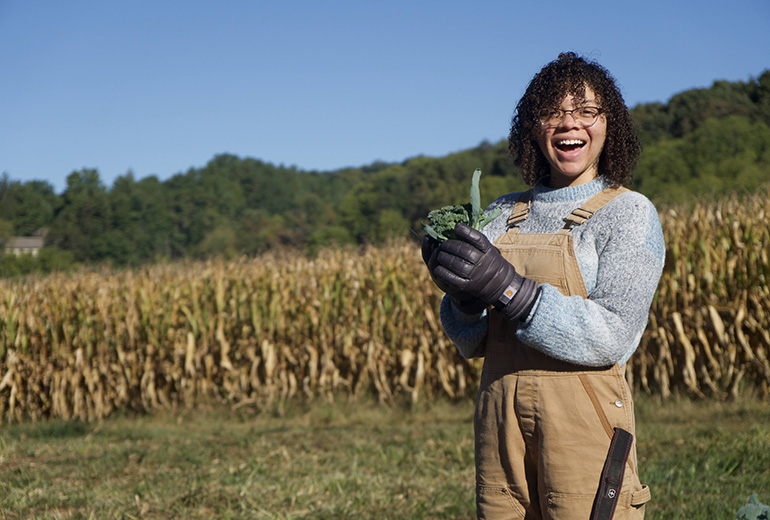
Warren Wilson College has a student-run campus garden that includes an herb crew, focused on growing herbs for use in things like salves and tea mixes, and the main garden crew, focused on growing food.
From farm to table, and back to farm
Warren Wilson College (WWC) has a robust sustainability program, allowing them to serve students locally harvested produce and meat, then use food waste to go back to the fields which grew that food.
WWC, located in Swannanoa, N.C., has a student-run campus garden that includes an herb crew, focused on growing herbs for use in things like salves and tea mixes, and the main garden crew, focused on growing food. Each week, they send WWC Dining chefs a list of what’s available, the chefs put in their orders, then get the fresh, local produce to incorporate into their menus for Gladfelter Dining Hall and Cowpie Café, according to Summer Vishnu, WWC Dining marketing & sustainability coordinator.
While WWC Dining hopes to use even more of the campus garden’s produce in their kitchens, Vishnu said, they also use produce from other local farms using food procurers in the area.
“They connect us with different farms within a 100-mile radius,” Vishnu said. “They are a great way for us to buy local produce.”
Not only is the dining program using hyper-local produce, it is also using meat from animals raised on the campus farm.
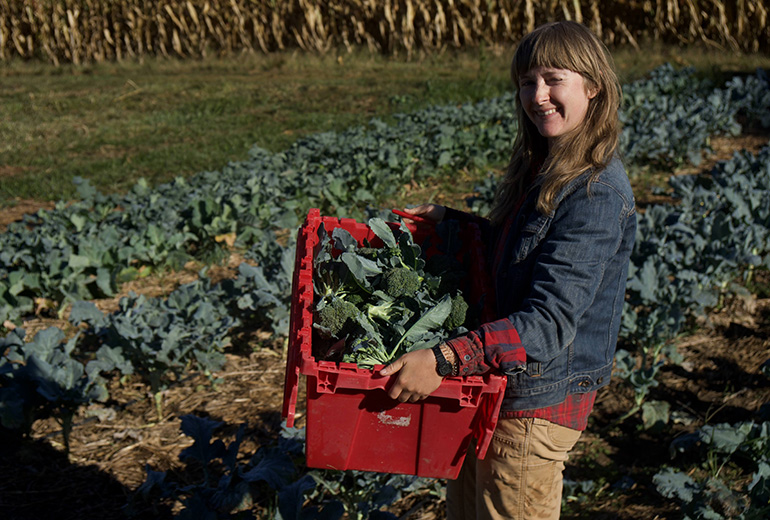
Each week, they send Warren Wilson Dining chefs get a list of what’s available from the campus garden, put in their orders, then get the fresh, local produce to incorporate into their menus.
“Almost 100 percent of our beef comes from the campus farm,” Vishnu said. “That’s a wonderful situation. Part of eating sustainably is eating as locally as possible.”
Students raise the animals, including cows, pigs, sheep and chickens, until they are ready to go to processing. The dining program is then able to purchase that meat, in addition to eggs from the chickens when they are producing.
On the menus for the cafes, WWC Dining notes what is from local sources, and what is directly from WWC farms. Students eat hyper-local food and know that what they’re eating is sustainable. Not only that, but when they’re done eating, they can further contribute to the sustainability process.
Composting is a big component of WWC Dining’s sustainability program. They work with the college’s Community-Orientated Regeneration Efforts (CORE) Crew, which oversees composting, recycling and sustainability on campus.
Composting scraps are collected at Gladfelter Dining Hall and Cowpie Café, both from students scraping materials off their plates, and the employees in the kitchens and dishrooms putting food waste into compost bins. The CORE Crew picks up these bins, loads them onto trucks, which take the waste a mere quarter-mile away to WWC’s composting site that uses aerated static pile composting. The compost made here goes back into the college’s garden, right back where we started.
Since the start of the spring semester, the kitchens produced 11,066 pounds of food waste, diverted to compost, according to the CORE Crew. Though that number is a bit lower than past semesters, that is partly due to some other places food has been diverted.
Starting in the spring semester, some of the waste has been diverted to pig buckets. Employees in the kitchens prepping vegetables will put small scraps into buckets that CORE Crew picks up to feed to the campus farm’s pigs.
Also this year WWC Dining has gone a step further, partnering with Food Connection to donate leftover food from the dining stations to benefit those in need. Since January, they have donated 2,450 pounds of food.
“We couldn’t do all of this without the help from the school and their crews,” Vishnu said, adding that she appreciates the uniqueness of the school to be able to provide these opportunities for sustainability.

Signage explains the Future 50 Foods philosophy at George Mason University.
GMU Future 50 Foods stations help students eat sustainably and nutritiously
When diners came to lunch at George Mason University (GMU) dining halls on a recent Monday, they found little card tents by each food item. While the card noted what the food was, it also was color-coded green, yellow, or red to indicate what the food’s carbon impact was.
All food has a carbon impact, which reflects the amount of greenhouse gas emissions that are caused by creating that food, whether it’s from cooking, growing, transporting, processing, or disposal. The cards with green card tents noted foods with the lowest carbon impact, such as beans and seasonal fruits and vegetables. Any red tents reflected foods with high carbon impact, such as meat, cheese, and eggs.
“These indicators invited guests to reflect on the process of how food gets to our plates,” Mason Dining Marketing Specialist Sophia Nelson said. “With more than 75% of our options having a low carbon impact, we invited students to opt for a sustainable diet.”
The carbon impact indictors are just a reminder of the work Mason Dining does every day to encourage students to eat sustainably. This work is largely seen at their Future 50 Foods stations.
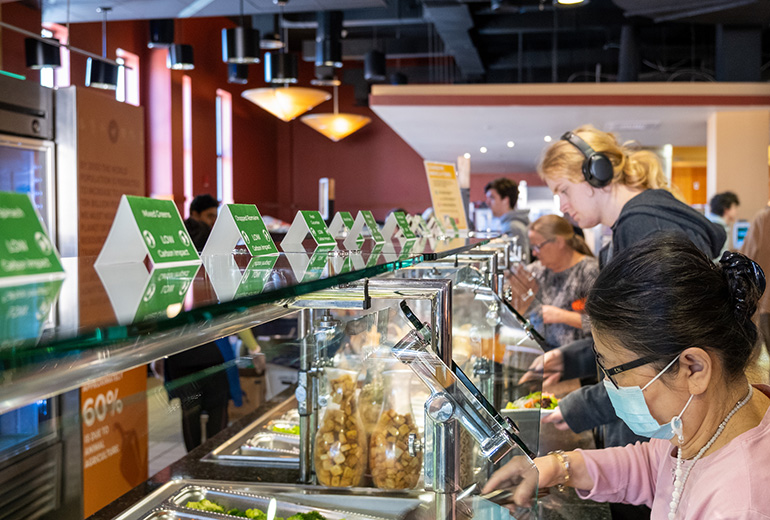
Color-coded cards on the serving line cite each menu item’s carbon impact.
In 2019 the World Wildlife Fund and Knorr identified 50 foods, known as Future 50 Foods, that have a lower environmental impact, as well as being nutritious. This school year, Mason Dining turned their existing salad bars at their Southside and Ike’s dining halls into Future 50 Food Stations that offer a rotating, wide range of food options. Students can build their own dishes, or select a featured dish, such as couscous salad or Hungarian goulash, created by the chefs using the Future 50 Foods.
“The whole program aims to provide students with a better understanding of where their food comes from, the impact of their dietary choices on the environment, how they can support local farmers, and how to eat healthier without sacrificing the taste,” Mason Dining Marketing Director Sofya Vetrova said.
Mason Dining Dietitian Brooke Tresch also uses Future 50 Foods in her campus events that help teach students how to eat healthy. One recent event taught students how to make overnight oats with flax seeds.
The program continues to grow in its sustainability, with the station offering ingredients such as lettuce grown at the campus greenhouse, as well as from local farmers and businesses. Additionally, since 2018 Mason Dining has been collecting food waste for composting.
While the program is a success in terms of sustainability, it also has success with customer satisfaction. Before the launch of the Future 50 Food stations, a survey of GMU students found that many supported a more plant-based diet. After the stations debuted, Mason Dining again surveyed students, who responded in vast majority that they enjoy eating at this plant-forward station.
“In response to the growing demand for flexitarian food options, it's important for universities like GMU to provide more plant-forward meals to address students’ needs,” Vetrova said. “Not only will this help create a healthier environment on campus, but it will also help universities attract and retain students who are looking for more vegetarian options.”
Tiffany Peden is a regional communications manager for Sodexo Universities

